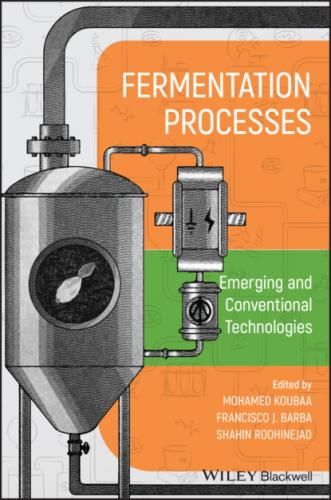1.1.6 Bioconversion
A microbial cell can be used to convert or transform any substance into a value‐added product (Garlapati et al. 2016), a bit like conventional conversions of grape must into wine, wine into vinegar, or milk into yogurt. These transformations contribute to producing very valuable compounds in the pharmaceutical industry, such as antibiotics, vitamins, steroids, and prostaglandins. These conversions are based on the biochemical reactions of microorganisms used such as hydroxylation, dehydroxylation, O‐methylation, O‐demethylation, glycosylation, deglycosylation, dehydrogenation, hydrogenation, C‐ring cleavage of the benzo‐γ‐pyrone system, cyclization, and carbonyl reduction (Cao et al. 2015).
The bioconversion of compounds by microorganisms is much more advantageous than the conventional chemical transformation because the reactions can occur at low temperature and low pressure and without the addition of catalysts. To understand the different steps required to carry out a fermentation process, it is of paramount importance to understand first the microbial metabolism and how a substrate could be transformed by a microorganism to maintain its growth and the production of targeted compounds.
1.2 Energetic Metabolism
Microorganisms need energy and carbon for their metabolism and are classified as autotrophs and heterotrophs depending on the sources of energy and nutrients (Misra 2011). There are only two sources of energy metabolizable by the cells: light energy captured during photosynthesis and energy from the oxidation of organic and inorganic molecules. Nevertheless, cells can be categorized into nutritional categories depending on how they meet these needs. In bioprocesses, three of these classes are potentially exploited on an industrial scale: phototrophs, chemolithotrophs, and chemoorganotrophs (Jurtshuk 1996).
Phototrophs use light as a source of energy and carbon dioxide (CO2) as a source of carbon. They include photosynthetic bacteria (cyanobacteria), algae, and green plants. Chemolithotrophs rely on electrons from reduced inorganic compounds, such as iron, nitrogen, or sulfur, as a source of energy (oxidation of the inorganic material) and CO2 as a carbon source. They include several bacterial species that are primarily used in environmental bioprocesses, particularly in aerobic wastewater treatment. The chemoorganotrophs use, as a source of energy, electrons from hydrogen atoms that are part of organic compounds (oxidation of organic matter), which also serve as a carbon source. They are the ones who enter the vast majority of bioprocesses, particularly in fermentation processes (bacteria, yeasts, and molds) and in animal cell cultures. The next sections will discuss the metabolism of this class of cells.
All living organisms need energy to grow and reproduce. In chemoorganotrophs, this energy is obtained during the degradation of organic compounds. Mainly, carbohydrates, lipids, and proteins are oxidized to release the chemical energy they contain. This energy will be then transferred to adenosine diphosphate (ADP) and inorganic phosphate (Pi) molecules before being stored in the form of adenosine triphosphate (ATP) (Figure 1.1). ADP and ATP correspond to molecules of adenosine monophosphate (AMP) plus one and two high‐energy phosphates (AMP ~ P and AMP ~ P ~ P, respectively). The energy is stored in these compounds as high‐energy phosphate bonds. All living cells must maintain steady‐state biochemical reactions for the formation and use of such high‐energy compounds.
Biochemical assimilation (anabolism) and dissimilation (catabolism) of nutrients by a chemoorganotroph are mediated by a network of enzymatic reactions perfectly synchronized and regulated. Anabolic pathways consist mainly of the reductive processes that lead to producing new cellular molecules, while catabolic pathways include the oxidative processes involved in removing electrons from substrates or intermediates that are used to generate energy.
Figure 1.1 Energy coupling and the role of ATP in microbial metabolism. ADP: adenosine diphosphate, ATP: adenosine triphosphate
1.2.1 Energy Transfer and Redox Reactions
The energy released by the catabolic reactions is associated with the electrons of molecules that are degraded during these reactions. This energy is transferred to a molecule of ADP to form ATP. More specifically, a phosphate group is added to the ADP molecule, with an energy investment, to form an ATP molecule (Figure 1.1). The energy contained in organic molecules cannot be released all at once; otherwise, it would be practically all lost in the form of heat, as during combustion. It must, therefore, be gradually transferred to the ATP molecules via the cascades of redox reactions.
First, the energetic nutrients are oxidized, which allow them to behave as electron donors (e−). During this reaction, two electrons and two protons (H+) are transferred to a coenzyme known as nicotinamide adenine dinucleotide (NAD+) to be reduced in the form of NADH + H+. A part of the chemical energy contained in nutrients is then transferred to the NAD+ by the electrons, according to the reduction reaction in Eq. (1.1).
Overall, each time an organic molecule is oxidized (the loss of electrons and H+ ions), there is simultaneously a reduction of NAD+ taking place. This is why we talk about “redox reactions.” The newly formed NADH will then undergo oxidation, in turn, to release stored energy (Eq. (1.2)), which will eventually be transferred to ATP molecules by various chemical processes.
At the end of the energy transfer process, the released electrons and protons (H+) must be picked up by a final acceptor. This acceptor will vary according to the preferred catabolic pathway: aerobic respiration, anaerobic respiration, or fermentation.
1.2.2 Aerobic Respiration
In this catabolic pathway, the final electron acceptor is molecular oxygen (O2), and the organisms using it are, therefore, dependent on air for their survival. It takes place in three stages, each involving a series of chemical reactions: glycolysis, citric acid cycle, and electron transport chain.
1.2.2.1 Glycolysis Pathway
In the glycolytic pathway, occurring in all tissues, glucose is oxidized to provide energy (i.e. ATP) and intermediates for other cellular metabolic pathways. Glycolysis is at the hub of carbohydrate metabolism where glucose is converted to pyruvate following a series of 10 enzymatic reactions (Figure 1.2). This metabolic pathway is known as aerobic glycolysis, as the reoxidation of the NADH formed during the oxidation of glyceraldehyde 3‐phosphate requires O2. Aerobic glycolysis sets the stage for
